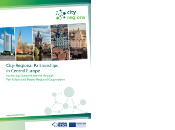The Prague Metropolitan Region consists of the Capital City of Prague and a large part of the surrounding Central Bohemia region. The city of Prague has 1,243,000 inhabitants, and at least 284,000 inhabitants of Central Bohemia live in the Prague suburban zone.
The Capital City of Prague is statutorily defined as a single municipality, but it also includes 57 self-governing entities (city districts). The Central Bohemia region has at least 1,147 municipalities. In general, as a result of historical development, the Czech Republic holds a unique position in Europe, with a high degree of segmentation of internal administration.
This situation is a crucial challenge for the coordination of local authorities in the Prague Metropolitan Region. So far, the available cooperation structures that would allow for complex solutions to mutual relations turn out to be not sufficient yet.
Description of the pilot scheme
The district of Prague 9 is located in the north-east of Prague and has 54,000 inhabitants. It does not have a border with the Central Bohemia region, but it is an important destination and transit area for commuters. Several important interchange hubs between railways, regional bus transport and urban transport (metro, tram) are located here, and many commuters use the opportunity to change in this area from individual to public transport.
The traffic situation is steadily worsening due to the increasing intensity of road transport and the delayed completion of the high-level road system. Due to high numbers of passing and parked cars, the flow of traffic is reduced, and vehicles of surface public transport are slowed down.
Due to delayed trams and buses, the availability of cars, and the prevailing metropolitan lifestyle, there is a further shift from public transport to individual transport. Additionally, non-motorised modes of transport (walking, cycling) still lack a coherent infrastructure that would allow to travel across the district away from road corridors.
In parallel, there is an intensive process of revitalisation of brownfield sites. In the plans of developers, these areas appear as housing areas, possibly with mixed administrative or commercial functions. Either way, the secondary effect will be a growing need for transport.
To solve these problems, it is necessary to establish close cooperation between the district of Prague 9 and institutions and entities engaged in the long-term solution of traffic issues. Cooperation and mutual awareness need also to be facilitated with regard to neighbouring districts, villages and towns located in the wider agglomeration zone surrounding the district of Prague 9.






